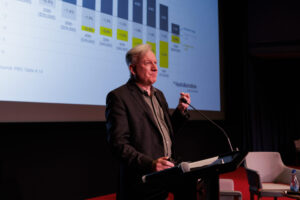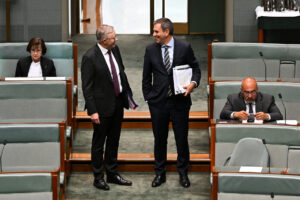Rebuilding the economy means government investment, but not all public spending is equal
We are living in the golden age of nationalisation, yet Australians’ imagination for the role of government is at an all-time low.
In the past seven years the Coalition government has committed to spending $50 billion on the NBN, $10 billion on an inland rail line, $7 billion for a second Sydney airport and $5 billion for Snowy 2.0. The publicly owned Australia Post kept the private sector going in recent months delivering nearly 2 million parcels per day; our submarine company, ASC, is gearing up to build and maintain $200 billion worth of submarines for our defence; our “green bank”, the Clean Energy Finance Corporation, has lent out $6.2 billion; and our logistics companies such as the Moorebank Intermodal Company and the Australian Rail Track Corporation play a key role in heavy freight movements around the country.
And that’s just at the federal level. The New South Wales government recently spent close to $1 billion so that it could knock down a stadium and – no kidding – build a smaller one, in part to make the crowds look bigger when people watch the game on TV. There’s never been a better time to promote nation building.
The rhetoric of “small government” conceals the reality that our federal government doesn’t just regularly intervene in markets, it often creates them from scratch. And often with great success. Between them, the Commonwealth Bank, Telstra, Qantas, MedibankPrivate and CSL (formerly the Commonwealth Serum Laboratories) are worth a combined $300 billion and account for nearly 20 per cent of the value of the ASX 200. Who says governments can’t pick winners.
In the past three months the government has announced $200 billion of new spending. That’s enough to buy back most of the companies we privatised, to build four more nationwide broadband networks or 40 projects the size of Snowy 2.0. If Snowy 2.0 was a “nation-building scheme”, the stimulus packages announced to date must be what? Planet building? But despite this spending, the rules of Australian public debate insist we mustn’t think too broadly or deeply about what we’d like to do with all that money. Debating public spending in Australia is like debating the best albums of all time and only being able to mention those released in the past 20 years, by bands from Canberra.
Prime Minister Scott Morrison’s insistence that the post-COVID recovery must be “business led” is as economically flawed as it is demonstrably nonsensical. The public sector has already provided a $90 billion line of credit to ensure the privately owned banks remain liquid (but nothing to super funds to help with urgent withdrawals), $300 million to regional airlines (but nothing for Virgin); $95 million for zoos (but nothing for public universities); and $50 million to the media industry (but nothing for artists).
Picking winners, or playing favourites, is what MPs do. Despite what they say, wherever possible they spend public money on the private ventures they like, and don’t spend it on the public institutions they don’t like. In the culture war that is Australian policy debate, funding for the ABC drives up our debt, but removing the local-content obligations of struggling commercial broadcasters saves jobs.
As we saw from the $100 million “sports rorts” affair, the $150 million “female facilities and water safety” infrastructure scheme, and the $1.1 billion Community Development Grants saga, Coalition MPs back themselves strongly when it comes to writing public cheques for private organisations.
There’s a simple reason conservatives spend so much time criticising public spending: it’s the easiest way to avoid having a public debate about what we should spend money on. Obviously the folks spending hundreds of billions of our money on their pet projects don’t have a problem with the idea of public spending, it’s just that their ideas for public spending aren’t very popular so they prefer not to debate them.
So what winners should we pick? The gas industry wants public money to build it a transcontinental pipeline and the coal industry wants us to build it a so-called high-efficiency low-emission coal-fired power station. But what if we built things that benefited our citizens rather than our corporations?
What new businesses should we build? And how should we choose between all of the options we face? Let’s start small. What could Australia do for the cost of one more Snowy 2.0?
You could install a lot of solar panels with battery storage for $5 billion. At a conservative $10,000 per system you could slash the electricity bills of half a million Australian families or community organisations. Rolling out such a program over three years would provide training pathways for tens of thousands of workers. And the end result would be to boost electricity supply, drive down power bills and lower Australian emissions.
But a small-scale project like that would be a missed opportunity. Putting solar panels on individual roofs is one of the most expensive ways to install renewables. It would be far cheaper for a newly created government-owned enterprise – let’s call it Solar 1.0 – to build a vast network of large solar farms around the country in places where land is cheap, there’s lots of sunshine, and where the distances to workers and customers isn’t too great. For the cost of two Snowy 2.0s we could be the owners of a $10 billion renewable and storage company as big as AGL, and we would still have spent only 5 per cent of the recent stimulus announcements.
But why stop at where our houses get their electricity? For $5 billion, we could build around 20,000 four-bedroom houses on Commonwealth or state government land. For the next 50 years the government could rent them out to women fleeing domestic violence, or to the unemployed, age pensioners, key workers or lifelong members of the Liberal Party. No matter who was deemed “worthy” enough to live in them, the houses would immediately create jobs where they are needed, and lower the general cost of housing for decades.
If that sounds radical, bear in mind that the government is already funding a similar scheme. According to the (not top secret) website of the publicly owned Defence Housing Australia: “We provide quality housing and related services to Defence members and families. In doing this, we support the operational, recruitment and retention goals of the Department of Defence. To meet our Defence housing obligations, we are active in Australian residential housing markets, acquiring and developing land, and constructing and purchasing houses.”
As of June 2019, Defence Housing Australia had 17,948 properties under management, worth a combined $11.2 billion. The organisation not only provided subsidised housing services to tens of thousands of Defence personnel and their families, it generated a profit of $40 million for its owners (that’s us).
Needless to say, Defence personnel are worthy recipients of publicly owned housing, but are they really the only worthy recipients? When did we have that debate? Soldiers, prime ministers and vice-chancellors get public housing, so why can’t nurses, teachers and the unemployed?
It’s not ideology or economics that stops the federal government investing in the things the public wants more of. It’s that we misunderstand what governments already do, and we’re reluctant to look into the simple truth hidden in plain sight: our governments have always been willing to spend a fortune helping some groups while pretending we “can’t afford” to support other groups.
Despite the enormous human and economic costs of COVID-19, Australia is still one of the richest countries in the world. While the federal government’s debt has grown to $441 billion, luckily our national income of $2009 billion means that our debt accounts for only 22 per cent of GDP, which is far lower than it was at the end of World War Two, and far lower than the advanced country average of 83 per cent.
The economic problem isn’t that we have taken on debt in the past few months. The economic problem is that we have never had a debate about what we want more of, so there is no chance all that debt can solve all of our problems. (Imagine if we didn’t let our kids decide what degree they did but made them pay HECS for it anyway.)
So how should we decide what to spend it on? If jobs are the priority, as is so often said, the first thing to realise is that in a recession any additional public-sector spending will create public-sector jobs. There is nothing economically magical about building roads or bridges. Spending billions on infrastructure will create some jobs, and spending billions on health and education will create even more.
The second thing to realise is that not all public spending creates the same number of jobs. Every million dollars spent on labour-intensive activities such as aged care and childcare creates, literally, 10 times as many jobs as a million dollars spent on construction or mining projects. And when it comes to creating jobs for women, government spending on education and health is much more effective than spending on construction or mining.
And, finally, if Australia builds things that the public wants more of, and will need in the future, there’s little chance that at the end of this crisis we will be stuck with things we don’t want or need. Economists have no unique skill in identifying which projects Australia should build, but luckily democracy does. If only we would put relevant questions to the public and listen to their answers. Now you see why the Coalition works so hard to pretend it’s opposed to public spending.
Between the Lines Newsletter
The biggest stories and the best analysis from the team at the Australia Institute, delivered to your inbox every fortnight.
You might also like
Stage 3 Better – Revenue Summit 2023
Presented to the Australia Institute’s Revenue Summit 2023, Greg Jericho’s address, “Stage 3 Better” outlines an exciting opportunity for the government to gain electoral ground and deliver better, fairer tax cuts for more Australians.
Richard Denniss: National Press Club Address
On Wednesday, 31 January 2024, Richard Denniss and Allegra Spender MP addressed the National Press Club for a debate on the Stage 3 tax reforms. **Check against delivery** [See below for transcripts] Tax is good. Tax is an investment in our society and the highest taxed countries in the world also happen to be the
RN Breakfast: Redesigning the Stage 3 Tax Cuts
Richard Denniss joins ABC RN Breakfast with Patricia Karvelas to discuss redesigning the Stage 3 tax cuts.



